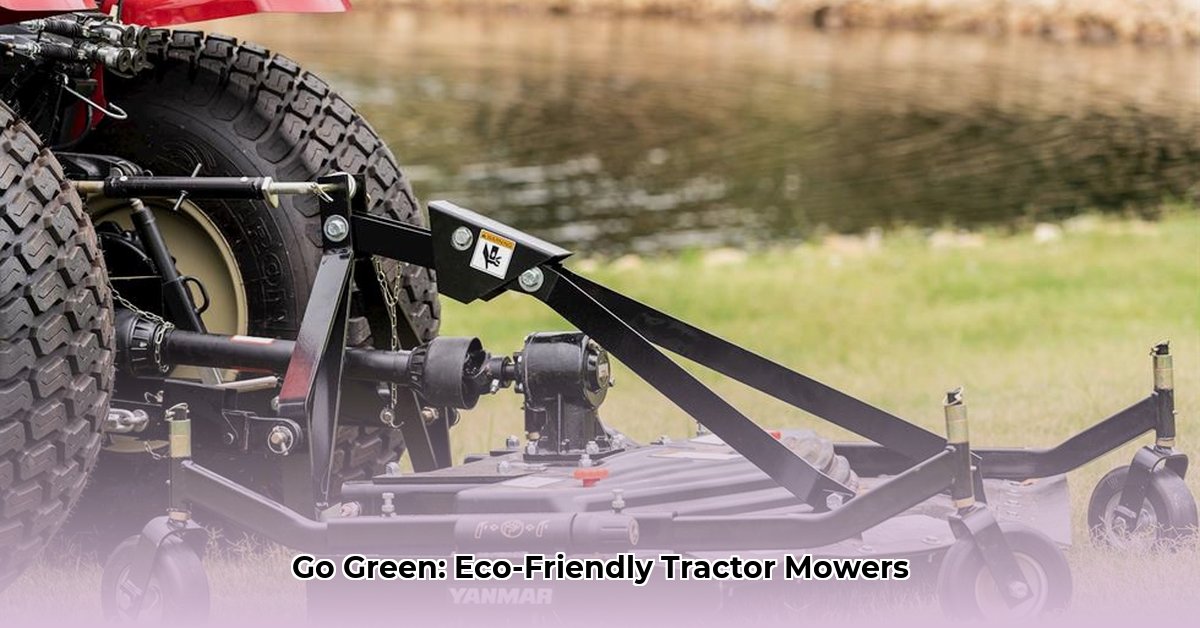
Choosing the right finish mower significantly impacts both your farm's efficiency and environmental footprint. This comprehensive guide helps you navigate the options, ensuring you select a mower that optimizes performance while minimizing your environmental impact. For more information on zero-turn mowers, check out this helpful resource: Simplicity Zero-Turn Mowers.
Finish Mowers: A Deep Dive into Types and Features
Several finish mower types cater to different agricultural needs. Understanding their strengths and weaknesses is crucial for making an informed decision.
Rotary Mowers
Rotary mowers are versatile and well-suited for various tasks, offering different cutting widths and discharge options. They provide a balance of performance and affordability. However, they may not be ideal for extremely delicate work or dense vegetation.
Drum Mowers
For precision cutting, drum mowers deliver a superior, clean cut. They are particularly well-suited for manicured lawns or areas requiring a delicate touch. Their slower cutting speed should be considered against the quality of the cut.
Flail Mowers
When tackling overgrown areas or dense vegetation, flail mowers are the heavy hitters. Their aggressive cutting style makes them ideal for clearing tough terrain, but they're less suitable for perfectly manicured areas.
Choosing the right mower depends on the specific characteristics of your farm, your budget, and your sustainability goals. Many farmers even use a combination of mower types to increase their overall versatility. Isn't versatility key to efficient farming?
Selecting the Right Finish Mower: A Decision Framework
Before purchasing a finish mower, carefully assess several key factors:
Farm Size and Terrain: How many acres require mowing, and what's the terrain like (flat, hilly, etc.)? This dictates the required cutting width and mower type (e.g., a wider mower is beneficial for large, flat fields). Consider your specific terrain when matching your tractor's capacity to the intended workload.
Crop Type and Desired Finish: What type of vegetation are you mowing (grass, alfalfa, etc.)? This impacts the choice of blades and cutting method. Do you require a perfectly manicured finish, or is a rougher cut acceptable? This affects mower selection and potentially leads to different maintenance schedules.
Budget and Sustainability Goals: Determine your budget and how important sustainability is to your operation. Fuel-efficient mowers might have a higher initial cost but save money in the long run.
Matching Tractor PTO Horsepower: A Critical Consideration
Matching your tractor's PTO (Power Take-Off) horsepower to the mower's requirements is crucial for safe and efficient operation. Underpowering your mower leads to damage, reduced productivity, and potential safety hazards, while overspending on a higher-powered mower than needed is simply inefficient. Always consult your tractor's manual and the mower's specifications to ensure compatibility. A well-matched system always leads to better performance.
Fuel Efficiency and Sustainable Mowing Practices
Fuel efficiency is a key aspect of sustainable farming. Minimizing fuel consumption reduces operational costs and your carbon footprint.
Regular Maintenance: Sharp blades, well-lubricated parts, and a clean air filter significantly improve fuel efficiency. Think of regular maintenance as an investment in both sustainability and increased longevity of your equipment.
Efficient Mowing Patterns: Overlapping passes ensure even cutting and reduces the need for multiple passes.
Engine Type: Consider fuel-efficient engine options, such as those designed for optimal power and minimal fuel consumption. The choice of engine significantly influences long-term fuel costs and your environmental impact.
Beyond fuel efficiency, consider the mower's lifespan and the environmental impact of its manufacturing and disposal. Look for mowers made from sustainable materials and designed for easy recycling.
Long-Term Cost Analysis: Total Cost of Ownership (TCO)
The total cost of ownership (TCO) encompasses more than just the initial purchase price. Calculating TCO helps you make well-informed financial decisions. Factors to consider include:
- Initial purchase price
- Fuel consumption
- Maintenance and repair costs
- Downtime costs
- Potential environmental disposal costs
This comprehensive approach helps weigh the initial investment against long-term operational expenses, leading to a more accurate reflection of ownership costs.
Future Trends in Sustainable Finish Mowing
Electric and hybrid mowers offer an exciting glimpse into the future of sustainable agriculture. While still developing, their reduced emissions and quieter operation offer compelling advantages. The advancement of battery technology is critical to their widespread adoption, and advancements in battery capacity and lifespan directly impact cost-effectiveness and environmental impact over the long term.
Actionable Steps for Sustainable Mowing
- Assess your farm's unique needs: This includes land size, terrain, crop types, and your budget.
- Research and compare various mower models: Explore different cutting widths, discharge methods, horsepower requirements, and sustainability features.
- Ensure proper tractor-mower compatibility: Match your tractor's PTO horsepower to the mower's requirements.
- Establish a comprehensive maintenance plan: Include regular lubrication, blade sharpening, and repairs.
- Optimize your mowing technique: Use overlapping passes to ensure even cutting and save fuel.
- Choose sustainable options: Prioritize fuel-efficient engines and mowers made with environmentally friendly materials.
This comprehensive guide empowers you to select a finish mower that enhances your farm's efficiency while minimizing your environmental footprint. Remember, sustainable practices are a commitment that benefits both your bottom line and the planet.